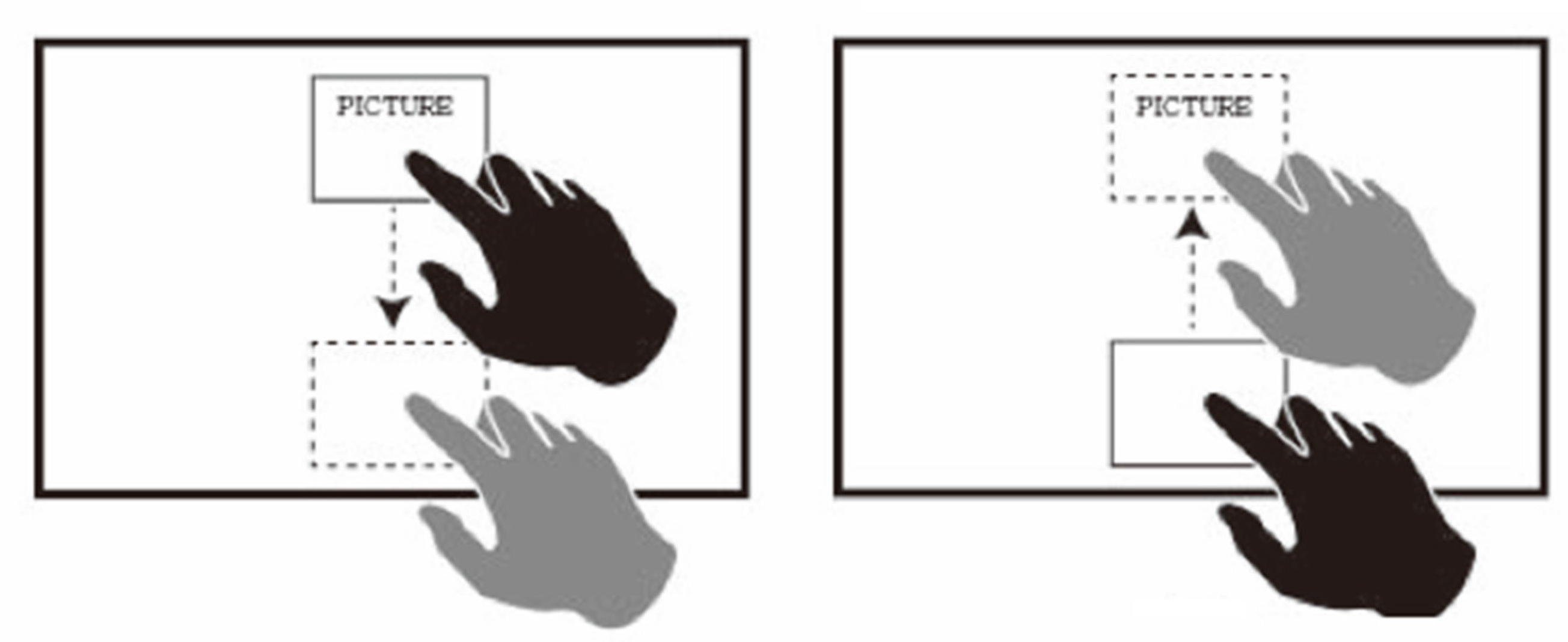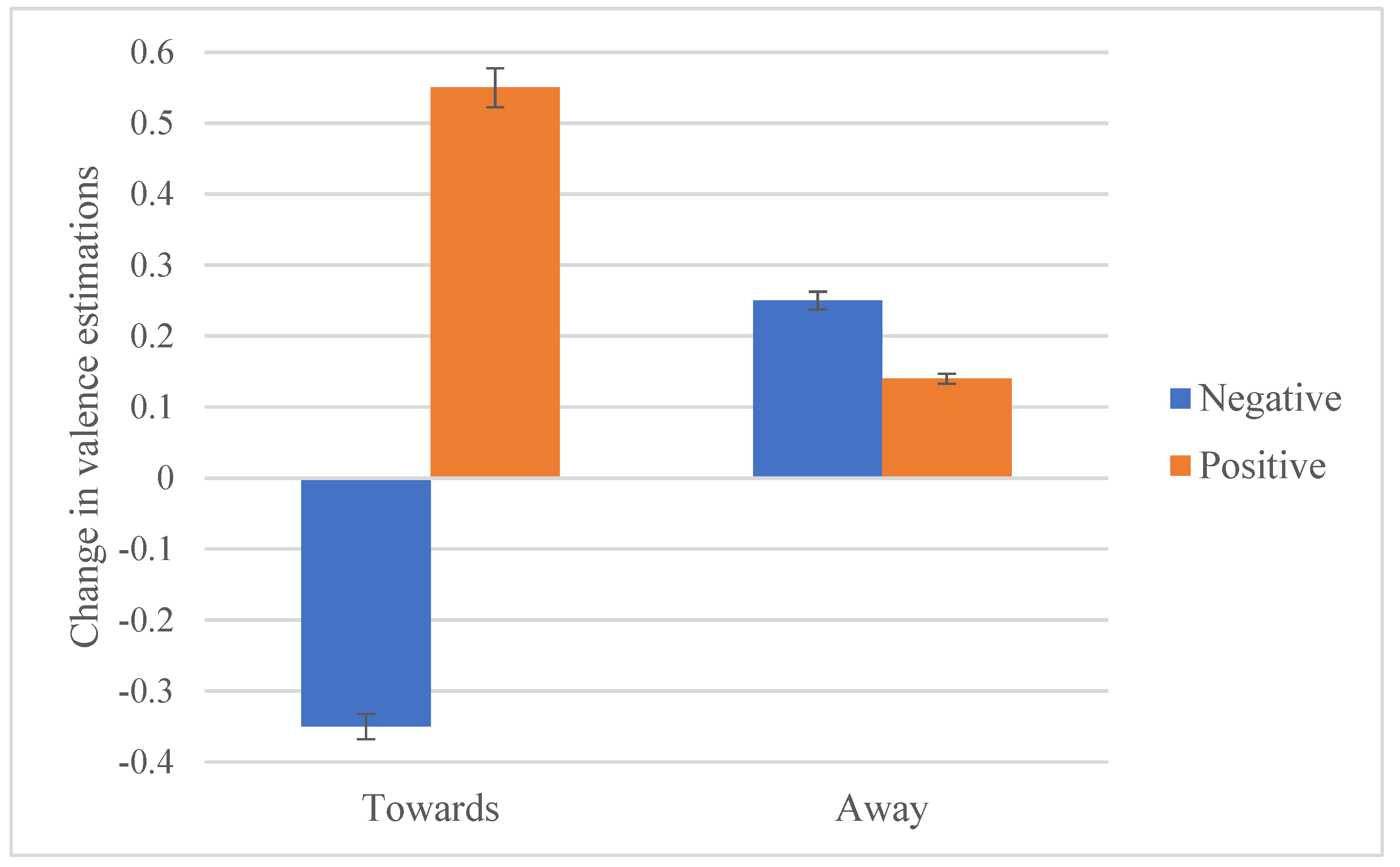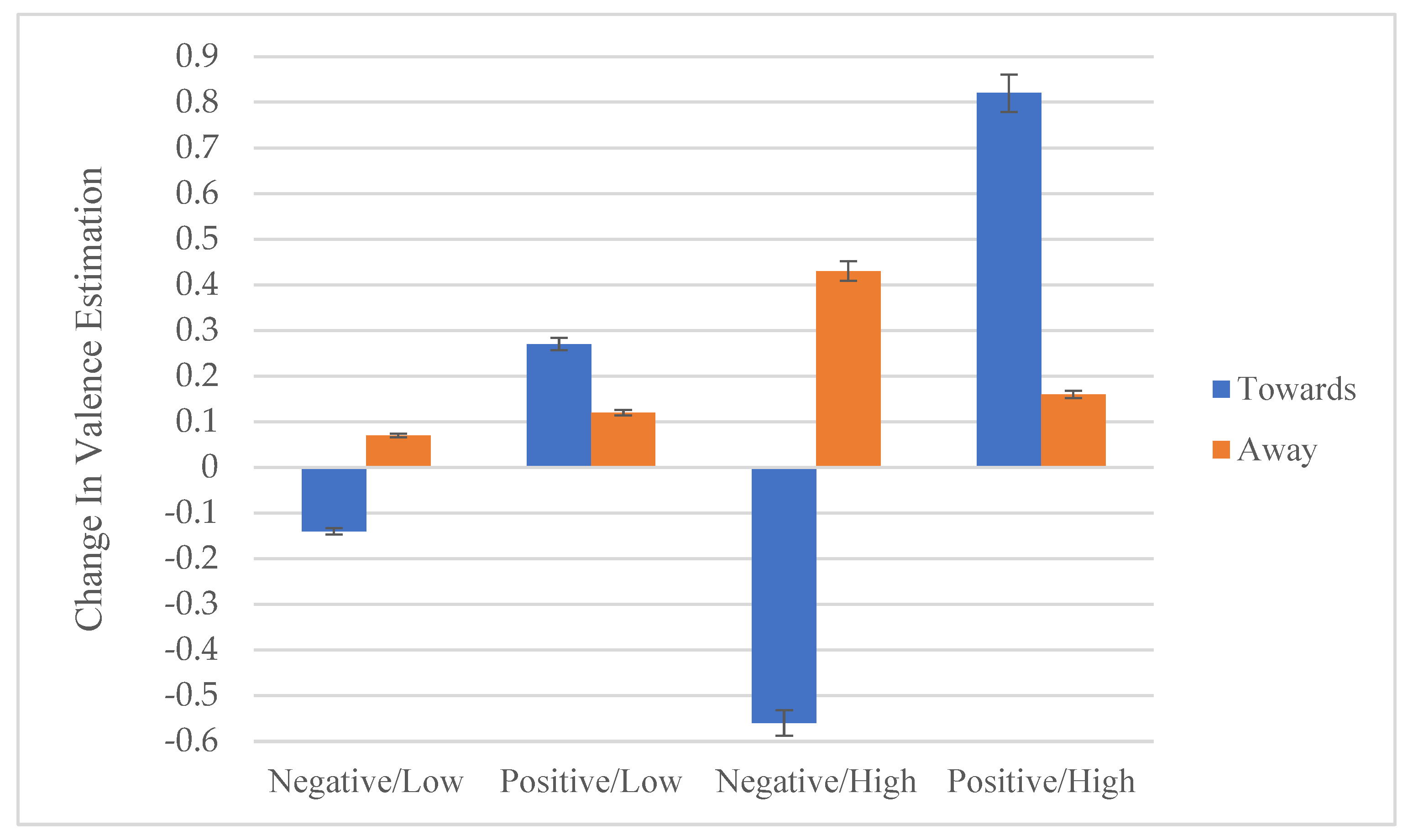Effects of Approach–Avoidance Swiping Interactions on the Valence Estimation Using Tablet AAT
Abstract
1. Introduction
- H1:
- The touchscreen tablet AAT is effective in measuring approach–avoidance behavior in the appraisal of emotion.
- H2:
- Minimum body movements (such as finger movements) influence subjects’ valence processing against embodied cognition. This means that the direct swiping movements with the pictures is relevant to influence the subjects’ valence estimation towards the pictures, an AACE is expected. The compatibility state (i.e., swiping positive pictures closer and negative pictures away) results in a relatively more positive change in the valence estimations.
- H3:
- The valence estimation is more sensitive to the negative valence stimuli with higher affective arousal. The stimuli with different levels of arousal have different effects on the affective cognition of the subjects’ approach–avoidance behaviors.
2. Martials and Methods
2.1. Participants
2.2. Materials and Apparatus
2.3. Procedure
2.4. Empirical Analyses
3. Results
3.1. Results on AACE
3.2. Results on the Effect of Arousal
4. Discussion
5. Conclusions
Author Contributions
Funding
Data Availability Statement
Acknowledgments
Conflicts of Interest
References
- Barsalou, L.W. Grounded cognition. Annu. Rev. Psychol. 2008, 59, 617–645. [Google Scholar] [CrossRef] [PubMed]
- Niedenthal, P.M. Embodying emotion. Science 2007, 316, 1002–1005. [Google Scholar] [CrossRef] [PubMed]
- Cervera-Torres, S.; Ruiz Fernández, M.; Lachmair, M.; Riekert, M.; Gerjets, P. Altering emotions near the hand: Approach–avoidance swipe interactions modulate the perceived valence of emotional pictures. Emotion 2019, 21, 220. [Google Scholar] [CrossRef] [PubMed]
- Cervera-Torres, S. Influencing Appraisals of Emotional Valence with Spatial Touchscreen Interactions: An Embodied Approach to Positive Technology. Ph.D. Dissertation, Universitätsbibliothek Tübingen, Tübingen, Germany, 2017. [Google Scholar]
- Mouilso, E.; Glenberg, A.M.; Havas, D.A.; Lindeman, L.M. Differences in action tendencies distinguish anger and sadness after comprehension of emotional sentences. In Proceedings of the 29th Annual Cognitive Science Society, Austin, TX, USA, 1–4 August 2007; Volume 14, pp. 1325–1330. [Google Scholar]
- Niedenthal, P.M.; Winkielman, P.; Mondillon, L.; Vermeulen, N. Embodiment of emotion concepts. J. Personal. Soc. Psychol. 2009, 96, 1120. [Google Scholar] [CrossRef]
- Cervera-Torres, S.; Ruiz Fernandez, S.; Lachmair, M.; Gerjets, P. Valence-space associations in touchscreen interactions: Valence match between emotional pictures and their vertical touch location leads to pictures’ positive estimation. PLoS ONE 2018, 13, e0199972. [Google Scholar] [CrossRef]
- Laham, S.M.; Kashima, Y.; Dix, J.; Wheeler, M. A meta-analysis of the facilitation of arm flexion and extension movements as a function of stimulus valence. Cogn. Emotioiin 2015, 29, 1069–1090. [Google Scholar] [CrossRef]
- Centerbar, D.B.; Clore, G.L. Do approach-avoidance actions create attitudes? Psychol. Sci. 2006, 17, 22–29. [Google Scholar] [CrossRef]
- Cretenet, J.; Dru, V. The influence of unilateral and bilateral arm flexion versus extension on judgments: An exploratory case of motor congruence. Emotion 2004, 4, 282. [Google Scholar] [CrossRef]
- Price, T.F.; Peterson, C.K.; Harmon-Jones, E. The emotive neuroscience of embodiment. Motiv. Emot. 2012, 36, 27–37. [Google Scholar] [CrossRef]
- Chen, M.; Bargh, J.A. Consequences of automatic estimation: Immediate behavioral predispositions to approach or avoid the stimulus. Personal. Soc. Psychol. Bull. 1999, 25, 215–224. [Google Scholar] [CrossRef]
- Halberstadt, J.; Winkielman, P.; Niedenthal, P.M.; Dalle, N. Emotional conception: How embodied emotion concepts guide perception and facial action. Psychol. Sci. 2009, 20, 1254–1261. [Google Scholar] [CrossRef] [PubMed]
- Solarz, A.K. Latency of instrumental responses as a function of compatibility with the meaning of eliciting verbal signs. J. Exp. Psychol. 1960, 59, 239. [Google Scholar] [CrossRef] [PubMed]
- Markman, A.B.; Brendl, C.M. Constraining theories of embodied cognition. Psychol. Sci. 2005, 16, 6–10. [Google Scholar] [CrossRef] [PubMed]
- Rinck, M.; Becker, E.S. Approach and avoidance in fear of spiders. J. Behav. Ther. Exp. Psychiatry 2007, 38, 105–120. [Google Scholar] [CrossRef]
- Brouwer, A.M.; van Beers, J.J.; Sabu, P.; Stuldreher, I.V.; Zech, H.G.; Kaneko, D. Measuring Implicit Approach–Avoidance Tendencies towards Food Using a Mobile Phone Outside the Lab. Foods 2021, 10, 1440. [Google Scholar] [CrossRef] [PubMed]
- Rinck, M.; Dapprich, A.; Lender, A.; Kahveci, S.; Blechert, J. Grab it or not? Measuring avoidance of spiders with touchscreen-based hand movements. J. Behav. Ther. Exp. Psychiatry 2021, 73, 101670. [Google Scholar] [CrossRef]
- Ikeda, S. Examining approach–avoidance responses to facial expressions using a tablet device. Curr. Psychol. 2022, 41, 1–4. [Google Scholar] [CrossRef]
- Brucker, B.; Brömme, R.; Ehrmann, A.; Edelmann, J.; Gerjets, P. Touching digital objects directly on multi-touch devices fosters learning about visual contents. Comput. Hum. Behav. 2021, 119, 106708. [Google Scholar] [CrossRef]
- Kret, M.E.; Bocanegra, B.R. Adaptive hot cognition: How emotion drives information processing and cognition steers affective processing. Front. Psychol. 2016, 7, 1920. [Google Scholar] [CrossRef]
- Lang, P.J.; Greenwald, M.K.; Bradley, M.M.; Hamm, A.O. Looking at pictures: Affective, facial, visceral, and behavioral reactions. Psychophysiology 1993, 30, 261–273. [Google Scholar] [CrossRef]
- Mather, M.; Sutherland, M.R. Arousal-biased competition in perception and memory. Perspect. Psychol. Sci. 2011, 6, 114–133. [Google Scholar] [CrossRef] [PubMed]
- Citron, F.M.M.; Abugaber, D.; Herbert, C. Approach and withdrawal tendencies during written word processing: Effects of task, emotional valence, and emotional arousal. Front. Psychol. 2016, 6, 1935. [Google Scholar] [CrossRef] [PubMed]
- Zsido, A.N.; Bernath, L.; Labadi, B.; Deak, A. Count on arousal: Introducing a new method for investigating the effects of emotional valence and arousal on visual search performance. Psychol. Res. 2020, 84, 1–14. [Google Scholar] [CrossRef] [PubMed]
- Cao, G.; Liu, P. Arousal modulates the motor interference effect stimulated by pictures of threatening animals. PeerJ 2021, 9, e10876. [Google Scholar] [CrossRef]
- Lang, P.; Bradley, M.M. The International Affective Picture System (IAPS) in the study of emotion and attention. Handb. Emot. Elicitation Assess. 2007, 29, 70–73. [Google Scholar]
- Mohammadbagher, M. Penetrative Thinking and Embodied Learning in VR. Doctoral Dissertation; The Pennsylvania State University: Pennsylvania, PN, USA, 2022. [Google Scholar]
- Johnson-Glenberg, M.C.; Megowan-Romanowicz, C.; Birchfield, D.A.; Savio-Ramos, C. Effects of embodied learning and digital platform on the retention of physics content: Centripetal force. Front. Psychol. 2016, 7, 1819. [Google Scholar] [CrossRef]
- Tang, R.; Li, J.; Wang, Z. Valence, arousal and appraisal of emotion influence the hand movement. Acta Psychol. Sin. 2019, 51, 890. [Google Scholar] [CrossRef]
- Kakoschke, N.; Hawker, C.; Castine, B.; de Courten, B.; Verdejo-Garcia, A. Smartphone-based cognitive bias modification training improves healthy food choice in obesity: A pilot study. Eur. Eat. Disord. Rev. 2018, 26, 526–532. [Google Scholar] [CrossRef]
- Meule, A.; Lender, A.; Richard, A.; Dinic, R.; Blechert, J. Approach–avoidance tendencies towards food: Measurement on a touchscreen and the role of attention and food craving. Appetite 2019, 137, 145–151. [Google Scholar] [CrossRef]
- Slepian, M.L.; Weisbuch, M.; Pauker, K.; Bastian, B.; Ambady, N. Fluid movement, and fluid social cognition: Bodily movement influences essentialist thought. Personal. Soc. Psychol. Bull. 2014, 40, 111–120. [Google Scholar] [CrossRef]
- Zech, H.G.; Rotteveel, M.; van Dijk, W.W.; van Dillen, L.F. A mobile approach-avoidance task. Behav. Res. Methods 2020, 52, 2085–2097. [Google Scholar] [CrossRef] [PubMed]
- Veenstra, L.; Schneider, I.K.; Bushman, B.J.; Koole, S.L. Drawn to danger: Trait anger predicts automatic approach behaviour to angry faces. Cogn. Emot. 2017, 31, 765–771. [Google Scholar] [CrossRef] [PubMed]
- Costello, M.C.; Bloesch, E.K. Are older adults less embodied? A review of age effects through the lens of embodied cognition. Front. Psychol. 2017, 8, 267. [Google Scholar] [CrossRef] [PubMed]



| Positive Valence | Negative Valence | |||
|---|---|---|---|---|
| Valence Scores | Arousal Scores | Valence Scores | Arousal Scores | |
| High arousal | 6.00 (0.23) | 5.88 (0.14) | 2.59 (0.55) | 5.86 (0.09) |
| Low arousal | 5.88 (0.19) | 4.28 (0.18) | 2.84 (0.18) | 4.19 (0.98) |
Publisher’s Note: MDPI stays neutral with regard to jurisdictional claims in published maps and institutional affiliations. |
© 2022 by the authors. Licensee MDPI, Basel, Switzerland. This article is an open access article distributed under the terms and conditions of the Creative Commons Attribution (CC BY) license (https://creativecommons.org/licenses/by/4.0/).
Share and Cite
Wang, X.; Hsu, Y.; Xu, R. Effects of Approach–Avoidance Swiping Interactions on the Valence Estimation Using Tablet AAT. Electronics 2022, 11, 4098. https://doi.org/10.3390/electronics11244098
Wang X, Hsu Y, Xu R. Effects of Approach–Avoidance Swiping Interactions on the Valence Estimation Using Tablet AAT. Electronics. 2022; 11(24):4098. https://doi.org/10.3390/electronics11244098
Chicago/Turabian StyleWang, Xinyan, Yen Hsu, and Rui Xu. 2022. "Effects of Approach–Avoidance Swiping Interactions on the Valence Estimation Using Tablet AAT" Electronics 11, no. 24: 4098. https://doi.org/10.3390/electronics11244098
APA StyleWang, X., Hsu, Y., & Xu, R. (2022). Effects of Approach–Avoidance Swiping Interactions on the Valence Estimation Using Tablet AAT. Electronics, 11(24), 4098. https://doi.org/10.3390/electronics11244098






